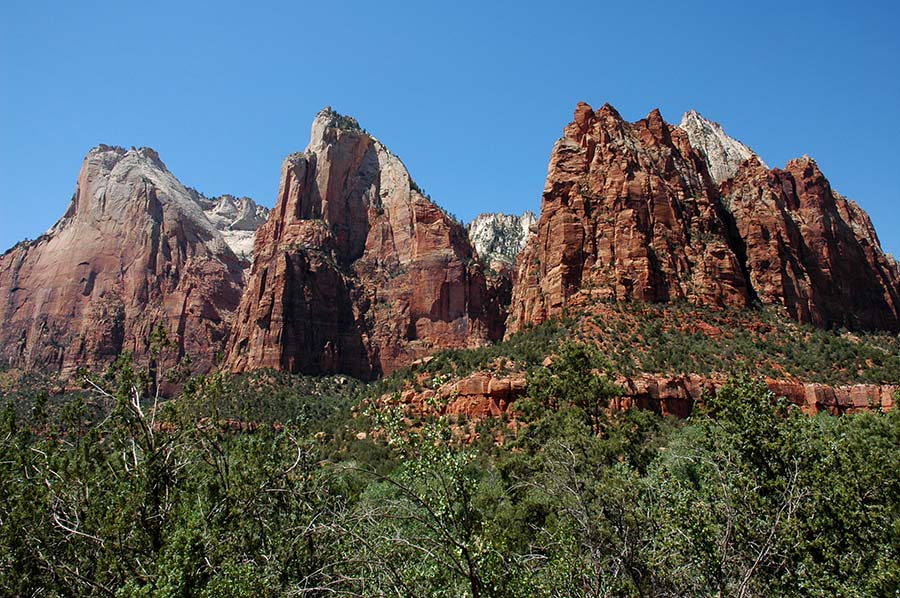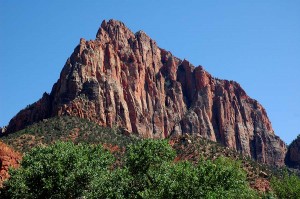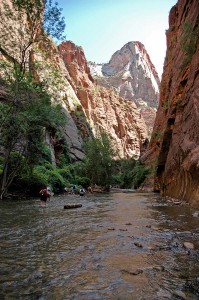 We traveled to Zion National Park for a visit two years ago and had a great time, and we’ll go back again. Here’s a recap of information on this fascinating park to help you get started if you’re thinking of a trip to Zion anytime soon. There’s also a lot of information available on the web in general, and on the park’s website at www.nps.gov/zion. This park is Utah’s oldest and most popular. It features spectacular scenic views and terrific hiking trails. There are four sections of the park to visit, but Zion Canyon is by far the most popular.
We traveled to Zion National Park for a visit two years ago and had a great time, and we’ll go back again. Here’s a recap of information on this fascinating park to help you get started if you’re thinking of a trip to Zion anytime soon. There’s also a lot of information available on the web in general, and on the park’s website at www.nps.gov/zion. This park is Utah’s oldest and most popular. It features spectacular scenic views and terrific hiking trails. There are four sections of the park to visit, but Zion Canyon is by far the most popular.
Zion National Park is located off State Route 9 in southwestern Utah. It’s open all year, but most visitors go there in the summer, as we did. The park encompasses 232 square miles and its elevation ranges from 3,666 to 8,726 feet. The climate is fairly mild with an average rainfall of 15 inches occurring mostly during winter and spring months. Entrance fees for a seven day pass are $25 per vehicle or $14 per individual, with seniors over 62 getting in for just $10. Luckily we have a Golden Age Passport so entry to all National Parks is free.
 We still tent camp and we stayed at the Watchman Campground next to the Visitor’s Center. That’s near the east entrance at the town of Springdale. The campground is comfortable and convenient with adequate sites and toilet facilities, but no showers. The small town of Springdale caters to park visitors and it’s just outside the park’s east entrance. There are places in town with hot showers available, but you’ll have to wait in line unless you get there early. Springdale also has a market, gift and boutique shopping, and great dining and lodging facilities if you don’t want to camp. Rooms and a couple of restaurants are also available at the Zion Lodge inside the park.
We still tent camp and we stayed at the Watchman Campground next to the Visitor’s Center. That’s near the east entrance at the town of Springdale. The campground is comfortable and convenient with adequate sites and toilet facilities, but no showers. The small town of Springdale caters to park visitors and it’s just outside the park’s east entrance. There are places in town with hot showers available, but you’ll have to wait in line unless you get there early. Springdale also has a market, gift and boutique shopping, and great dining and lodging facilities if you don’t want to camp. Rooms and a couple of restaurants are also available at the Zion Lodge inside the park.
 I recommend that everyone start their visit at the Visitor’s Center. It has a ton of information available, and it also features ranger-led talks, hikes, and evening programs popular with the kids. That’s where you get permits for backpacking, climbing, or other permit-required activities, too. This is canyon country and hiking is hot and dry during summer months, so carry water. Treated water is available at campgrounds, and at the Lodge or Visitor’s Center, but don’t drink from the river. A few things to note! Pets are not welcome in National Parks because of the wildlife and Zion is no exception. Dogs are not allowed on trails or the shuttle bus even when on a leash. This may be inconvenient for some of you, so plan accordingly.
I recommend that everyone start their visit at the Visitor’s Center. It has a ton of information available, and it also features ranger-led talks, hikes, and evening programs popular with the kids. That’s where you get permits for backpacking, climbing, or other permit-required activities, too. This is canyon country and hiking is hot and dry during summer months, so carry water. Treated water is available at campgrounds, and at the Lodge or Visitor’s Center, but don’t drink from the river. A few things to note! Pets are not welcome in National Parks because of the wildlife and Zion is no exception. Dogs are not allowed on trails or the shuttle bus even when on a leash. This may be inconvenient for some of you, so plan accordingly.
 There is a mandatory free shuttle service for Canyon Scenic Drive and it runs about every 20 minutes. We loved this service – for us it was the best way to get around the park. You can drive on the Zion-Mt. Carmel Highway, but there are restrictions for oversized vehicles. If you’re coming in a motor home or towing a boat check these out in advance. The shuttle stops at all trailheads on its one hour round trip. I suggest that you take advantage of stops at the Human History Museum for an interesting movie presentation about the park early during your visit. If you get hungry around lunch time, stop at the Lodge where there’s a snack bar (the Castle Dome Café). In fact the first thing we did was to ride the shuttle route just to scope out the action. That’s a good way to help you plan your itinerary.
There is a mandatory free shuttle service for Canyon Scenic Drive and it runs about every 20 minutes. We loved this service – for us it was the best way to get around the park. You can drive on the Zion-Mt. Carmel Highway, but there are restrictions for oversized vehicles. If you’re coming in a motor home or towing a boat check these out in advance. The shuttle stops at all trailheads on its one hour round trip. I suggest that you take advantage of stops at the Human History Museum for an interesting movie presentation about the park early during your visit. If you get hungry around lunch time, stop at the Lodge where there’s a snack bar (the Castle Dome Café). In fact the first thing we did was to ride the shuttle route just to scope out the action. That’s a good way to help you plan your itinerary.
Some other facts to note and check on: This is not a place to go fishing, it stinks, but a Utah license will let you test the waters of the Virgin River if you are a diehard. There are six species of native fish available, but most aren’t very tasty. Clearly, hiking and climbing are the most popular activities in the park. We all have our own special interests and there’s a lot to choose from here. There are almost 800 species of native plants, 15 types of reptiles, and a wide variety of birds including Condors, Golden Eagles, and Peregrine Falcons. It’s a true escape – cell phones don’t work in many areas of the park.
 Here are a few suggestions for activities to consider. The River Walk Trail is great. It’s a short hike to the end of the trail, but then you hit the Virgin River and wade up the narrow slot-canyon riverbed as far as you wish to go. It’s a spectacular trip as long as there’s no rain or the possibility of a flash flood. Bring water shoes. Two other short walks we enjoyed included the Weeping Rock Trail – it’s really short and easy, and the walk to Emerald Pool, also easy. Harder treks that are popular are hikes to Observation Point or The Narrows. The Angel Landing Trail is popular if you’re in shape and not afraid of heights. This 2.5 mile one-way walk climbs 1,500 feet to spectacular straight-down views of the canyon below. The last half mile, called Scout’s Lookout, is a cliff hanger though, and many people turn around before attempting that part of the trail. Remember, one of the park’s mottos is “Your safety is your responsibility,” so act accordingly.
Here are a few suggestions for activities to consider. The River Walk Trail is great. It’s a short hike to the end of the trail, but then you hit the Virgin River and wade up the narrow slot-canyon riverbed as far as you wish to go. It’s a spectacular trip as long as there’s no rain or the possibility of a flash flood. Bring water shoes. Two other short walks we enjoyed included the Weeping Rock Trail – it’s really short and easy, and the walk to Emerald Pool, also easy. Harder treks that are popular are hikes to Observation Point or The Narrows. The Angel Landing Trail is popular if you’re in shape and not afraid of heights. This 2.5 mile one-way walk climbs 1,500 feet to spectacular straight-down views of the canyon below. The last half mile, called Scout’s Lookout, is a cliff hanger though, and many people turn around before attempting that part of the trail. Remember, one of the park’s mottos is “Your safety is your responsibility,” so act accordingly.
Zion is a great scenic hiking trip, and we recommend that you give it a try if you get the chance. Our National Parks all have different things to offer, and the only real way to find out what those things are, is to go there.
